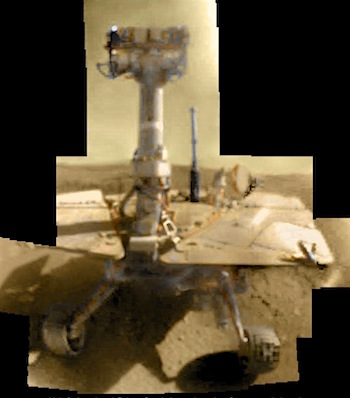 March 5, 2018: Opportunity Logs 5000th Day, Snaps Selfie, and Roves On: The Mars Exploration Rovers (MER) mission has made so many scientific discoveries and established so many records so consistently during the last 14 years that Opportunity’s achievements have become so commonplace they often go unreported in the major newsfeeds these days. But when Opportunity’s 5000th day dawned in February, it was a meaningful milestone for the team, and it led to a personal first for the veteran robot field geologist that has chalked up so many firsts she’s set the standard for Mars rovers.
March 5, 2018: Opportunity Logs 5000th Day, Snaps Selfie, and Roves On: The Mars Exploration Rovers (MER) mission has made so many scientific discoveries and established so many records so consistently during the last 14 years that Opportunity’s achievements have become so commonplace they often go unreported in the major newsfeeds these days. But when Opportunity’s 5000th day dawned in February, it was a meaningful milestone for the team, and it led to a personal first for the veteran robot field geologist that has chalked up so many firsts she’s set the standard for Mars rovers.
“Five thousand is a very, very big number,” said MER Principal Investigator Steve Squyres of Cornell University. (…) “I felt confidant that as long as we survived the landings that we would get 90 days out of the vehicles,” Squyres remembered. “I was pretty confident that we would get twice that, six months. And maybe, maybe if things really went our way, as much as one year. But 5000 sols?” He just shakes his head side to side. (…)
In recent weeks, Opportunity has been sending home images of rocks distinguished by their rough, pitted exterior that could, perhaps, indicate a volcanic origin, along with images of terrain surfaces that look like stone stripes, little formations where the soil and gravel particles appear to have become organized into narrow rows or corrugations parallel to the slope, alternating between rows with more gravel and rows with less. These rocks and the stone stripes may be hints that the mission is driving deeper into Mars’ geological history.
“We don’t know what happened here yet,” cautioned Arvidson. “But we’re going to take our time to find out what’s going on.” The general plan forward and the objective remain the same. “It’s all about continuing downhill and looking at the morphological features, the chemistry, and the fine scale details, the sediment fill and the modern fill, and the stone stripes to decipher what’s going on, what formed this valley.” (…)
Opportunity is budgeted to keep exploring Endeavour through 2018. At NASA HQ’s request, the MER team officials are preparing an 11th mission extension proposal for 2019. (From that point, mission extensions, according to reports, will be submitted every three years as opposed to every two as it is now and has previously been.)
“If everything goes well,” summed up Squyres, “we should be here next year with a bigger number of completed sols, more cool stuff to talk about, and a plan for the next mission extension.” [Much more at link]








